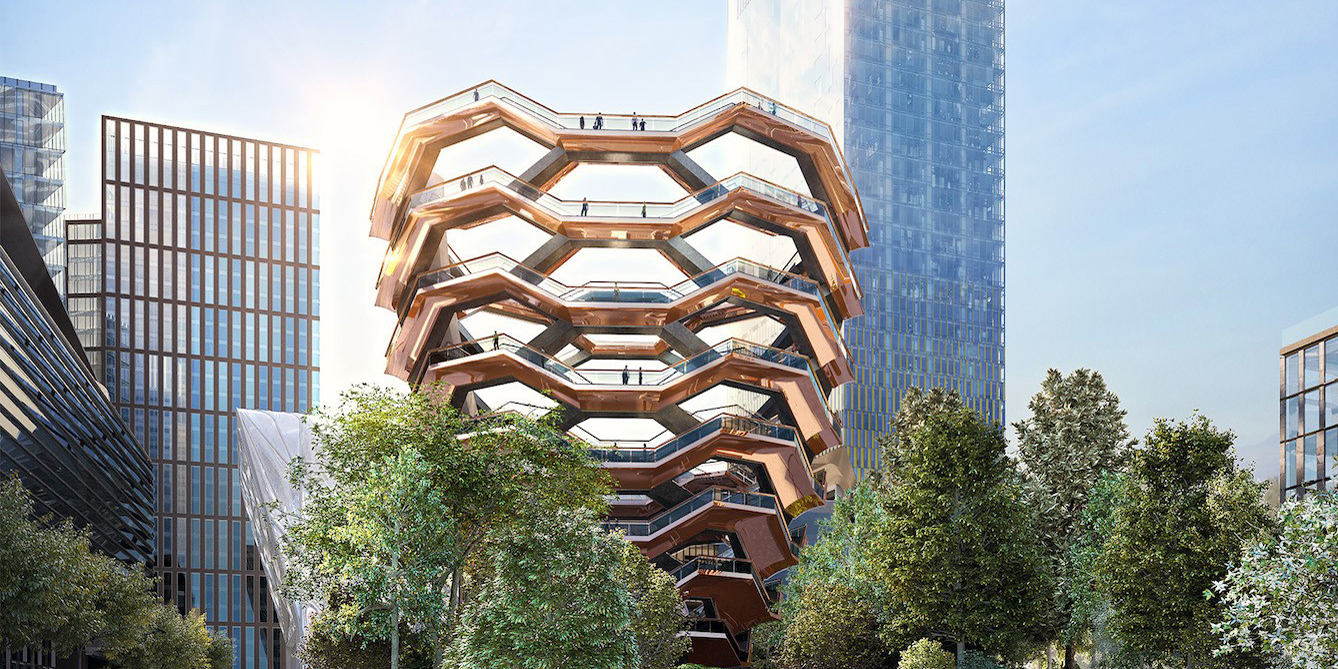
Architecture is a uniquely human creation. There has been a coincidence of aesthetic hubris and the tragedy of inconsolable hopelessness in New York City. Four people have died at the newly installed architectural structure, entirely trivial in its intention and aesthetics as its unintended use is disastrous.
The design of this architectural foolishness was meant to beckon its use as a lyric counterpoint to a dystopian vision of unhuman size and scale. New York City’s Hudson Yards is a massive $25 billion development on Manhattan’s far west side. It opened a few years ago, after seven years of construction and boasted the obligatory gathering of “world class” architect designed buildings. At the heart of Hudson Yards stands the greatest folly of them all — “The Vessel” by designer Thomas Heatherwick, of Heatherwick Studios, a 15-story, $200 million, meaningless staircase to nowhere.
The project revolted nearly every critic. What was built was not the Rockefeller Center of the 21st century, but a herd of boxy towers, each with its own slight perversity. The sight of ungainly, uncoordinated, bloated glass stalagmites reaching up to nothing but vainglory, facing nothing but each other, felt dystopian. In the Guardian, Hamilton Nolan called it an “ultra-capitalist … billionaire’s fantasy.”
“The Vessel” sits sad in comparison to the other movement-based architectural event nearby, the High Line. The critics were even harder on The Vessel than the numbing towers around it. Bad reviews might kill a musical, but these buildings and those empty stairs will last for generations.
“The Vessel” is virtually a “fool boggler” sculpture that weaves a basket of steps rising up to see the Hudson River. But as massive as the artwork is, it is nevertheless dwarfed by the huge glass towers surrounding it. Staircases are a design element directly keyed to our human scale. Each step is both ascendant and a danger if poorly created — heights, widths, railings even materials are fully in service to the humans that use stairs. Their aesthetic delight only comes after their usefulness as a way to move is accommodated by their design.
The surrounding scale-less gigantism of the towers is as inhuman as the pedestrian steps avail themselves to any walker. This irony has been the scene of those who have lost all hope in a world that does not sustain them. After three deaths there were signs placed, efforts at a buddy system, even a $10 admission fee to regulate access. But this summer, there was a fourth death. A creation meant to thrill its users has become a tragedy. The Vessel was rightly shut down, its entrance barred shut. There are now calls for its destruction.
Art and commerce are driven by promises of salvation. We do what we can to become what we want to be, usually in full ignorance of the insanely unmerited gift of life within each of us. We fail to achieve what we want in a world we did not make, with bodies and minds we were given, not earned. The folly of The Vessel is just one way that humans can pretend that we can control life — by making a thing, we can control happiness, if not create it. The hubris of it all is deadly, on all levels. The very act of manifesting our vision beyond any sense of God’s complete gift of life to every living thing is inevitable. We are made to deny our frailty only to inevitably experience it.
Life is the central gift of being that humans use to create things like Harbor Yard and The Vessel to express that gift. The tragedy of our incapacity to accept the love of God and the world around us is so understandable that it is terrifying. We can deny God’s grace in many ways, but at the very least, we should see how every human’s belief in our own control is the central folly of our humanity.
When we span a river with a high bridge or create density with a tall skyscraper what we build to answer a need can be be deadly. The collateral damage of human tragedy was never intended, but when we make a 21st century Tower To Ego Fulfillment our vain glory is our motivation. The flip side of hubris is despondency. That binary has been found in The Vessel.
The Vessel may never open again. Architectural Record’s editor-in-chief Cathleen McGuigan wrote in an op-ed released shortly after the last tragedy of the Vessel called for its demolition: “Not only does the tragedy of four [deaths] mark the Vessel … but the idea that this gargantuan chunk of shiny, copper-colored steel is a sculptural amenity for the citizens of New York is the biggest folly of all.”
We are folly who make our follies. God forgive us, we so often do not know what we do.
NOTE: If you are thinking about suicide, are worried about a friend or loved one, or would like emotional support, the Lifeline network is available 24/7 across the United States. The number to call is: 800-273-8255

COMMENTS
One response to “A Devastating Act of Hubris”
Leave a Reply













[…] In Mockingbird: A Devastating Act of Hubris […]